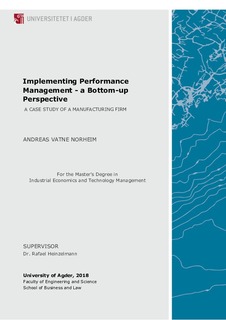| dc.description.abstract | In 2016, a world-class manufacturing plant, determined to remain competitive in the future, develop a business system to spread their vision and values throughout the organization. This business, inspired by principles from both Lean and Toyota Production System, has greatly emphasized the Kaizen Philosophy – where subordinates play a key role in the optimization of their work processes. This led to a plethora of process improvements, yet as the lack of focus was prominent, and the impact of these improvement efforts was hard to measure.
Management acknowledged a need for strategic directions, and in 2017 a pilot project to implement performance management was launched. However, as suggested by Jordan and Messner (2012), implementation of performance management systems are quite complicated. Furthermore, literature suggests user involvement during the design phase could be beneficial (Wouters & Wilderom, 2008). Thus, with aspirations to draw on their first-hand experience to increase the completeness, two departments developed their own key performance indicators (KPIs). This single-case study has, through qualitative interviews and observations, examined how the bottom-up development has influenced the completeness of these KPIs and the middle-management’s perception of the process.
The findings of this thesis suggest that a bottom-up development dramatically increases the completeness of the KPIs from the subordinate’s perspective. Nonetheless, the specificity of these KPIs intensify the incompleteness of the KPIs from management’s perspective, who actively search for the bigger picture. Even though both neither middle-managers involved in the project personally utilized, to a great extent, the performance management data, both were pleased with the learning and the enhanced internal transparency outcomes from the project. | nb_NO |

